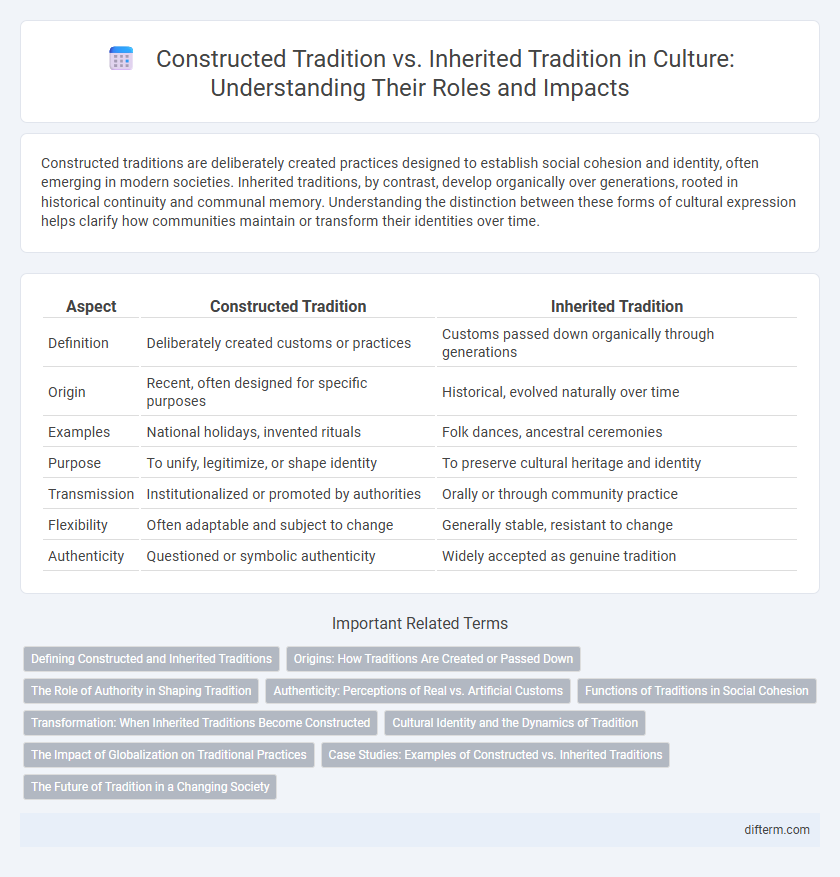Constructed traditions are deliberately created practices designed to establish social cohesion and identity, often emerging in modern societies. Inherited traditions, by contrast, develop organically over generations, rooted in historical continuity and communal memory. Understanding the distinction between these forms of cultural expression helps clarify how communities maintain or transform their identities over time.
Table of Comparison
| Aspect | Constructed Tradition | Inherited Tradition |
|---|---|---|
| Definition | Deliberately created customs or practices | Customs passed down organically through generations |
| Origin | Recent, often designed for specific purposes | Historical, evolved naturally over time |
| Examples | National holidays, invented rituals | Folk dances, ancestral ceremonies |
| Purpose | To unify, legitimize, or shape identity | To preserve cultural heritage and identity |
| Transmission | Institutionalized or promoted by authorities | Orally or through community practice |
| Flexibility | Often adaptable and subject to change | Generally stable, resistant to change |
| Authenticity | Questioned or symbolic authenticity | Widely accepted as genuine tradition |
Defining Constructed and Inherited Traditions
Constructed traditions are consciously created practices designed to establish social cohesion or legitimize institutions, often emerging in response to modern societal needs. Inherited traditions originate from historical customs passed down through generations, embodying collective memory and cultural identity. Both forms shape cultural expression but differ in their origins and functions within societies.
Origins: How Traditions Are Created or Passed Down
Constructed traditions emerge from deliberate creation, often in response to social or political needs, blending innovation with selective historical elements to establish new cultural practices. Inherited traditions, by contrast, are transmitted organically across generations, rooted in long-standing communal experiences and shared memories that create a sense of identity and continuity. Understanding the origins of traditions reveals the dynamic interplay between intentional invention and natural preservation within cultural evolution.
The Role of Authority in Shaping Tradition
Authority shapes constructed traditions by intentionally creating symbols and rituals to unify groups and legitimize power, while inherited traditions evolve organically through long-term social practices and collective memory. Leaders and institutions play a pivotal role in codifying and promoting constructed traditions to reinforce social cohesion and cultural identity. In contrast, inherited traditions gain authority through historical continuity and community acceptance rather than formal endorsement.
Authenticity: Perceptions of Real vs. Artificial Customs
Perceptions of authenticity in culture hinge on the distinction between constructed traditions--deliberately created practices often rooted in modern invention--and inherited traditions transmitted organically across generations. Authentic customs derive their legitimacy from historical continuity and communal acceptance, whereas constructed traditions may be viewed as artificial or performative, despite their role in reinforcing social cohesion. The debate over real versus artificial customs reflects broader questions about identity, cultural preservation, and the dynamics of adaptation in contemporary societies.
Functions of Traditions in Social Cohesion
Constructed traditions serve as deliberate practices designed to reinforce social cohesion by creating a shared sense of identity and continuity within a group. Inherited traditions, passed down through generations, naturally embed collective memories and values that strengthen communal bonds and social stability. Both types of traditions function as mechanisms for fostering group solidarity, guiding social behavior, and legitimizing social institutions.
Transformation: When Inherited Traditions Become Constructed
Inherited traditions often undergo transformation when communities reinterpret and adapt them to contemporary contexts, effectively turning them into constructed traditions. This process involves selective reinvention, where certain elements are emphasized or modified to align with present-day values and social needs, thereby ensuring cultural continuity. Constructed traditions, though rooted in historical practices, serve as dynamic instruments for identity formation and social cohesion in modern societies.
Cultural Identity and the Dynamics of Tradition
Constructed traditions often serve as deliberate creations to forge or reinforce cultural identity, adapting symbols and rituals to new social contexts. Inherited traditions carry the weight of historical continuity, grounding communities in shared memories and practices passed down through generations. The dynamic interplay between these forms of tradition shapes cultural identity by balancing innovation with preservation, ensuring cultural resilience amid societal change.
The Impact of Globalization on Traditional Practices
Globalization accelerates the blending of constructed traditions, which are deliberately created or revived to forge group identity, with inherited traditions passed down through generations. This fusion often leads to the adaptation or reinterpretation of traditional practices, enhancing cultural dynamism but sometimes risking the erosion of authentic heritage. Digital media and international exchanges play pivotal roles in reshaping rituals, festivals, and customs, enabling traditions to evolve while maintaining relevance in a globalized world.
Case Studies: Examples of Constructed vs. Inherited Traditions
Constructed traditions are deliberately created practices that serve contemporary social or political purposes, such as the emergence of Oktoberfest as a global symbol of Bavarian culture, while inherited traditions like Japan's tea ceremony have been passed down through generations, embodying historical continuity and cultural identity. Case studies reveal that constructed traditions often respond to modern needs for identity reinforcement, evident in the revival of Scottish Highland games, contrasting with inherited traditions that emphasize preservation, such as the Navajo rug weaving techniques maintained over centuries. These examples illustrate critical differences in authenticity, function, and societal impact between artificially constructed and organically inherited cultural practices.
The Future of Tradition in a Changing Society
Constructed traditions are deliberately created practices designed to shape collective identity and adapt to contemporary societal needs, while inherited traditions are passed down organically through generations, embodying historical continuity. In a rapidly changing society, the future of tradition hinges on balancing innovation with respect for cultural heritage, ensuring traditions remain relevant and inclusive. Embracing hybrid forms that combine constructed and inherited elements can foster resilience and cultural dynamism amid globalization and technological advancements.
constructed tradition vs inherited tradition Infographic

 difterm.com
difterm.com